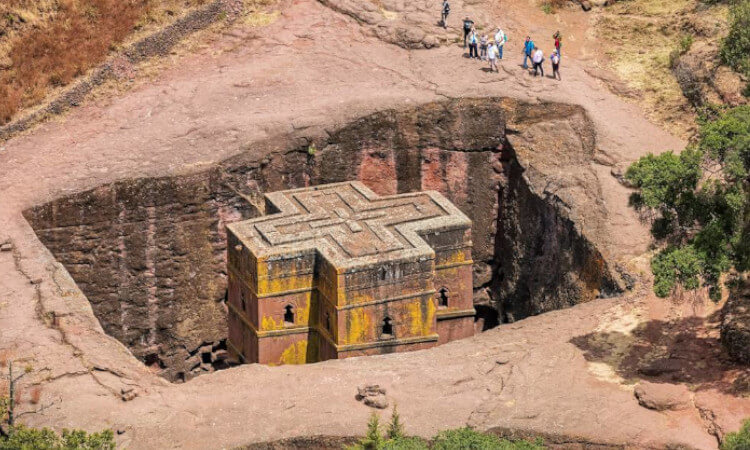LALIBELA
ROCK-HEWN CHURCHES OF LALIBELA
This page gives you highlights of the rock churches of Lalibela, North Ethiopia. Merit Ethiopian Experience Tours [MEET] organizes private tours to Lalibela.
LALIBELA ROCK CHURCHES, ETHIOPIA – One of the most significant African architectural accomplishments
As one of the most significant architectural achievements in the African Continent, the monolithic churches of Lalibela are carved directly out of rock.
All the doors, windows, wall decorations, chambers, etc. of Lalibela churches are all chiseled out from the living stone. A few of rock churches in Lalibela are even connected with subterranean passageways.
All the 11 rock-hewn churches of Lalibela are still in use for church (religious) purposes.
Comprising eleven churches and two chapels, Ethiopia's labyrinthine ‘New Jerusalem’, excavated by King Lalibela in the 12th century and still in active use today, has been dubbed the “Eighth Wonder of the World”. Hand-carved into the rock flake by painstaking flake, a process that would have required around 40,000 man-years to complete, Lalibela represents the apex of an Ethiopian church-excavating tradition that dates to the arrival of Christianity circa 350 AD.
One of the greatest architectural achievements of Ethiopians is the 11 monolithic churches of Lalibela. The magnificent 13th Century AD rock churches of Lalibela show sophisticated architectural skills. What makes Lalibela rock churches more amazing is that they are all carved out of red volcanic tuff using simple hand tools.
The following are a few important facts about Lalibela rock churches and why you may take a tour to visit these unique churches.
 • Many of Lalibela’s churches are subterranean monoliths, created in two stages. First, a quadrangle of trenches up to 15 meters deep would be hand-cut into a horizontal rock surface. Only then could the artisans commence work on the actual church, which was excavated into a massive freestanding central block enclosed by the artificial trenches.
• Many of Lalibela’s churches are subterranean monoliths, created in two stages. First, a quadrangle of trenches up to 15 meters deep would be hand-cut into a horizontal rock surface. Only then could the artisans commence work on the actual church, which was excavated into a massive freestanding central block enclosed by the artificial trenches.
• The church of Bete Medhane Alem (Saint George), set in one such subterranean courtyard, is the world's largest rock-hewn excavation, supported by 36 internal and 36 external pillars.
• The most iconic church at Lalibela, Bete Giorgis, is a freestanding monolith carved in the shape of a cross and dedicated to its namesake Saint George. Legend has it that Saint George was so delighted when he saw his church that he rode his horse over the entrance tunnel, leaving behind hoof prints that are still visible today.
• The impact of Lalibela is not limited to its architecture. This is also one of the very few UNESCO World Heritage Sites of comparable vintage that functions as a living shrine, one whose ancient stone churches have remained in active use since their excavation almost nine centuries ago.
• The countryside around Lalibela is studded with many other ancient churches. These include Yemrehanna Kristos, one of the finest surviving examples of Aksumite architecture, constructed in the 11th century with alternating layers of wood and gypsum-faced granite.
If you are in Addis Ababa and have two days for visiting the rock churches of Lalibela, check out our Two Days Tour to Lalibela by flight from Addis Ababa.
MERIT ETHIOPIAN EXPERIENCE TOURS [MEET]
Book EthioPerience!

Contact us soon at
Call us on +251-911-360488 OR +251-963-078067
Drop us a message or chat with us on WhatsApp
Twitter - Follow us on Twitter



